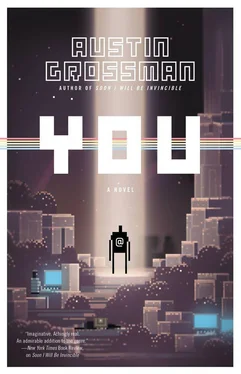July 14: “Texture-mapping error makes Prendar’s pants the same color as his skin ergo appears to be wearing no pants.” 100% repro for that build. “REPEAT PRENDAR HAS NO PANTS.”
July 18: The thermomantic spell Ice Storm had a bug in which it tried to reference the Giant Hailstone object and instead found the Pony object, which resulted in the spell Pony Storm, in which the caster fires a spray of between six and eight ponies at the target. Fixed, although we kept it open as long as we possibly could.
Lisa hid a secret spell in the necromantic arsenal. By combining elements of Poison Fog and a reversed Cure Disease, the caster could initiate a plague that could potentially depopulate the world. Not a bug, we decided, and hid the formula deep in the library of an abandoned castle half consumed by ocean.
Most bugs were more prosaic. “Fell through world (x = 65.7, y = 3809.1).” This one was a constant for months. No one ever stopped falling through the ground. I’d find it, too, constantly—one minute the world is a solid thing, the next you’re watching it disappear into the distance above you while you fall through white space, never to return. For an instant you’d see nearly a whole kingdom above you, then you’d splatter against the ultimate lower elevation limit of the world and the sad truth that all of Endoria lives inside a colorless rectangular box.
I walked by a machine that was doing nothing but showing split-second glimpses of Realms levels. It would appear, look around for a second, then vanish and appear somewhere else. I watched it for a while. Forest… dungeon… mountain… too fast to follow. Lisa had written a script to render a single frame of the game, teleport, and render another frame, logging everything that happened until the game crashed. Longest duration so far, sixty-one minutes.
Endoria was being atomized until it was hard to think of it as a place at all—the long, haunted walk north after the mountain pass, which seemed like an endless, grueling rite of passage in the extended playthroughs, seemed like an obvious trick when you knew you could teleport from one end to another in an instant. There was no ten-league stretch of forest, it reminded you; there was just a set of numbers. It was just data. In the same way, playing hide-and-seek with the marauders who have sailed upriver, it could take hours, days, to find your way through to the Endorian coast, where at last you reach the Lonely Tower and find the eerie Plutonian Dagger still gripped in the dead, unfeeling hand of the wielder who came before you. But the dagger was just a check box on a spreadsheet you could pull up in the editor. A click of a button and it’s yours.
It started to feel like a miracle every time you took a step and found solid ground, or every time anything in Endoria behaved like the coherent reality I once imagined it to be. The secret truth was that the thing we had created had a gossamer delicacy, and any given piece of it had a hundred options as to how to behave in any given situation. It would only pick the correct one if half a dozen different systems coordinated exactly correctly, systems typically maintained by people sitting in different parts of the building who might or might not be speaking to one another on a given day.
The sword was coming more and more often. After E3 we saw it at least once a week. Todd watched it destroy all the life in a crowded city, an hour and fifteen minutes to bare streets and empty houses. Even the rats were gone. Afterward, he reformatted the hard disk twice before reinstalling everything.
“I just… didn’t like it,” he explained.
I came into the playtest room to find them crowded around a single machine; we watched a berserk halfling on the far side of a metal grating; it bobbled back and forth for a few minutes, then chopped through the grating. Everyone flinched as the screen flashed red; another player character down.
“Not supposed to do that,” a long-haired tester muttered.
We had nine weeks to get through beta, which was an arbitrary length of time that had been set with no actual regard for how much work it represented. We fixed hundreds of bugs a day, which seemed impressive until I realized that the number of bugs was still increasing. We couldn’t even think of bringing the bug count down until we tamed the rate at which new bugs were discovered. Black Sword bugs were all assigned to me, as the original owner, but I noticed no one was asking me about it.
My bug list was flooded, and it wasn’t until the third weekend in September that I found time to play through the rest of the Nick Prendergast games. I had to; there was no other way to find Mournblade. But it also meant facing the fact that first-person shooters ruined Nick Prendergast. The debonair, slightly hapless spy became a hardened one-man killing machine, fully capable of storming through a division of Russian infantry and leaving behind nothing but well-searched corpses.
In 1992, id Software shipped Wolfenstein 3D, the first game that let you sprint through three-dimensional corridors, killing anything that moved. I can only picture Darren and Simon sitting at their monitors partly inspired but mostly aghast that they had been so massively, atrociously scooped. Every advance in video game graphics looks definitive; everything before it looks pathetic. They stared into the hacked 3-D perspective sliding past them. No more cartoons; this was an enchanted mirror, and Simon felt the otherworldly breeze blowing through it. Holy fucking shit.
Simon stayed up until dawn three nights in a row taking apart what John Carmack had wrought and reverse engineering it. It wasn’t that difficult when he looked at it. It cut every possible corner. You were looking into a flat maze; there was no variation in floor heights; it was all walls and ninety-degree angles; there was no looking up or down, and the floor and ceiling were featureless planes. It minimized the number of problems the computer had to solve, but in a clever way. Simon worked rapidly, knowing that everybody else interested in the problem was thinking the same way.
There was going to be a land rush into the third dimension of virtuality. As soon as he had the engine in hand, Darren lost no time in putting it to use. They would need to occupy and monetize, get their brand and their reputation out there. Nick Prendergast was the logical choice; he’d sold well, and he fit the context. The poor man was called back into service, his license to kill renewed and then some.
Clandestine II: Love Never Thinks Twice (1992)
Gone was the quaint two-dimensional animated figure ambling across colorful backdrops. Prendergast had disappeared—or, rather, you saw the world from his point of view. The new Nick was simply a gun hovering in midair, scanning the world.
Gone was the slender, slightly schoolmasterish, and, let’s face it, virginal Nick. He was done with fooling around picking locks and making chitchat with this or that baroness. There was no apparent plot. Nick was deployed like an infantry brigade to sterilize any square mile of rooms and corridors his spymaster deemed a threat. It would in general have been more humane to carpet-bomb a given area rather than to dispatch Nick Prendergast in first-person shooter mode. Enemies made just as little sense. They’d pop out of dead-end alleys or closets or basements as if they’d been living their whole lives there, waiting for Nick to walk past. In between, there were colorful graphics of Nick indulging his new interest in sports cars and East German strippers.
Clandestine II outsold every Black Arts game in history, and for a few years Black Arts turned into a factory for Clandestine sequels. One thing didn’t change, and that was the untouchable spymaster Karoly, who would dog his steps for the length and breadth of the franchise. Karoly was obsessed with ending the Cold War by acquiring a weapon of transcendent destructiveness, which he was always on the edge of obtaining. He was the Wile E. Coyote of the Soviet intelligence apparatus.
Читать дальше





![Ally Carter - [Gallagher Girls 01] I'd Tell You I Love You But Then I'd Have to Kill You](/books/262179/ally-carter-gallagher-girls-01-i-d-tell-you-i-lo-thumb.webp)






